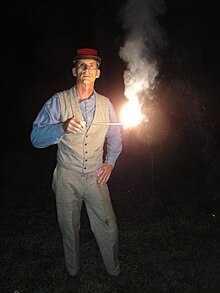Blue light (pyrotechnic signal)

Blue light is an archaic signal, the progenitor of modern pyrotechnic flares. Blue light consists of a loose, chemical composition burned in an open, hand-held hemispherical wooden cup, and so is more akin to the flashpan signals of the Admiral Nelson era than the modern, encased signal flares, which are often launched by mortar or rifle and suspended by parachute. Widely used during the eighteenth and nineteenth centuries for signaling by the world's military forces, and for general illumination in the civilian sector, blue light was remarkable for its use of poisonous arsenic compounds (realgar and orpiment), which contributed to its replacement by safer flares in the early twentieth century.
Confusion with blue-colored lanterns
[edit]Blue light was famously mentioned in accounts of the H.L. Hunley, the Confederate submarine which became the first to sink an enemy vessel, the USS Housatonic, on February 17, 1864, during the Civil War.[1][2] Such blue light has been repeatedly misidentified by authors and researchers of the Hunley story as a blue lantern, since they failed to realize the 1864 meaning of "blue light" as it was known to eyewitnesses who testified to its use during the battle between the Hunley and Housatonic.[3] Pyrotechnic blue light was commonly used by the vessels of the Federal South Atlantic Blockading Squadron off of Charleston, South Carolina[4] and would have been a familiar sight to both Union and Confederate soldiers and sailors.
Recipes for blue light appear in early chemistry texts[5] and often included antimony or copper compounds meant to add a blue color, but by the time of the American Civil War, standard military texts listed recipes for blue light which lacked any such coloring agent.[6][7] While the generic moniker "blue light" was retained, the pyrotechnic signal was meant to burn with a vivid, white light.[8] Modern authors have been confused by the generic name of blue light, and have imagined incorrectly that the signal which was seen during the Hunley - Housatonic encounter was blue. The oil lantern which archeologists at the Warren Lasch Conservation Center recovered from the Hunley submarine has a clear, not a blue, glass lens,[9] further evidence which discounts the modern "blue lantern myth" of the Hunley. Blue light as made in 1864 has been reproduced according to the two recipes listed in period texts[10][11] and has been tested with success over the same distances involved in the Hunley engagement.
Decline
[edit]Blue light has been obsolete for signaling since early in the twentieth century, but pyrotechnic lighting is still popular for celebratory fireworks displays, and its synonyms[citation needed] "Bengal light" and "Bengal fire" can still be found in modern pyrotechnic manuals. Such displays were also popular in nineteenth century civilian life: two hundred blue lights were used in the first illumination of Niagara Falls during the 1860 North American visit of the Prince of Wales.[12][13]
As a nickname
[edit]"Blue Light" was a derisive nickname given to military officers of the 18th and 19th centuries, whose evangelical Christian zeal burned as brightly as its namesake signal, to the chagrin of those less ardent.[14] During the American Civil War, Confederate General Stonewall Jackson carried the nickname "Old Blue Light" because his men said his eyes glowed with a blue light when battle commenced Shelby Foote, The Civil War; the nickname is referenced in the lyrics of "Stonewall Jackson's Way" (penned circa 1862).
References
[edit]- ^ Proceedings of the Naval Court of Inquiry on the Sinking of the Housatonic NARA Microfilm Publication M 273, reel 169, Records of the Judge Advocate General (Navy) Record Group 125
- ^ J.N. Cardozzo, Reminiscences of Charleston (Charleston, 1866) p. 124. Google Book search Dec. 10, 2011
- ^ Noah Webster, International Dictionary of the English Language Comprising the issues of 1864, 1879 and 1884, ed. Noah Porter, p. 137 at www.archive.org/details/webstersinternat01webs Accessed Dec. 10, 2011
- ^ Report of Lieutenant-Commander W.D. Whiting (commanding the USS Ottawa off Charleston, 22 January 1863); ORN I, 13, PP. 525-526
- ^ Samuel Frederick Gray (1828). The Operative Chemist. p. 499.
- ^ The Ordnance Manual for the Use of the Officers of the United States Army (3rd ed.). 1861. p. 307.
- ^ J.G. Benton (1862). A Course of Instruction in Ordnance and Gunnery Compiled for the Use of the Cadets of the United States Military Academy (2nd ed.). p. 369.
- ^ George William Francis (1842). Chemical Experiments: Illustrating the Theory, Practice and Application of the Science of Chemistry. London. p. 152.
- ^ Tom Chaffin (2008). The Hunley: The Secret Hope of The Confederacy. New York. p. 242.
{{cite book}}: CS1 maint: location missing publisher (link) - ^ Ordnance Manual, p.307
- ^ Benton, p.369
- ^ "News from Londonderry". The Times. Cumberland, England. 1860-09-26. Retrieved 2020-06-12.
- ^ "Illumination of Niagara Falls". Retrieved 2020-06-12.
Mr. Blackwell [...] had some 200 Bengal lights made of the largest size which it was possible to manufacture. About 20 of these were placed in a row under the cliffs, beneath Clifton House, and facing the American fall: 20 more were placed under table rock, and 20 more behind the sheet of water itself [...]
- ^ Gareth Atkins, review of Evangelicals in the Royal Navy, 1775-1815: Blue Lights and Psalm-Singers by Richard Blake (review no. 799) accessed Dec. 24, 2011 at www.history.ac.uk/reviews/review/799
Further reading
[edit]- Christopher Rucker (Spring 2012). "Blue Light and the H.L. Hunley Debunking the Blue Lantern Myth". Civil War Navy the Magazine. 1 (1): 6.
